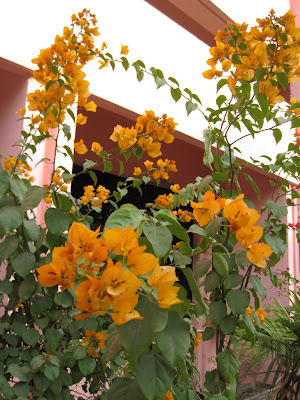One of the most fascinating aspects of the culture of the state of Orissa, besides its long-standing, well-preserved historic temples, its distinct culinary flavor, the hospitality of the people, is its dance. The traditional dance of Orissa is a language as well as it is an embodiment of religious stories. We were fortunate enough to attend, on this short trip, two fantastic acts: the Odissi dance performance of the Orissa Dance Academy, and the Gotipua acrobatic dance performed by the young boys from the artisan village. Both were captivating, exhilarating and inspirational in their own ways.
We went to visit the Orissa Dance Academy at around 7pm on Wednesday, when night dance classes were still taking place. On walking through the gate, I got a peak at a group of young dancers rehearsing their routine. They stepped in unison as the teacher clapped his hand to keep rhythm. Our interaction with the Dance Academy allowed us to learn about the single stances and dance moves in each act and what they represent. With regards to content, there are two main types: the one that tells the stories from religious tales and the pure act that focuses more on the ensemble of moves. In religious dances, three principal and most common steps are: the tribhanga (derived from the pose of Lord Jagannath, patron lord of Orissa), the bhramari, and the khandi. Each of them has multiple variations that were singly demonstrated to us by the dancers. A sense of continuity and perfection was felt throughout each act because there is one move that connects all: whether it be the flute-holding posture of Lord Krishna, the mirror-holding in the hands of the female dancer, or peacock pose.
The technicality requires not only stamina but also a great deal of full-body coordination and balance. The eyes and their movement play an important part in the dance, for the emotions they reflect and exude. Another aspect that kept me watching was the sparkling and delicate outfit of the dance crew, which helped enhance the visual effect greatly. We watched the dancers with much admiration and excitement, camera flashing, eyes wide open and smiles lingering. I pondered upon how amazing it is for the people to be able to preserve such a beautiful cultural element, which has taken and will take generations for its continuation.
It is a tradition that has resisted the powerful absorption power of globalization. It is for the pride, the respect and the endearment for this culture from each dancer that keeps Odissi dance from being essentially commercialized, lost or forgotten. Had money been the motivator, the dance masters would be putting its tradition at the mercy of market preference, which will not stand the test of time. Instead, these dance masters certainly has a long-term vision in mind. These days, dance groups like the Orissa Dance Academy travel the world to introduce their culture and tell their stories. The younger dancers will dance until around thirty years old, when they become a dance teacher and continue the cycle, passing down their knowledge and passion for Odissi dance.
The six Gotipua boys came to us at our resort in Puri showcasing their talents for acrobatic dance. Most of them are 5-12 of age, but the level of discipline, concentration and resilience they display were quite respectable. Their act spanned 45 minutes, with remarkable coordination, leaving us all at awe. Each has a role to play in marking it a successful performance, but you could spot out a couple that really anchored the act. They did tumbling, body-staggering, and everything in between. Once again, the full-body coordination and the articulate eye movement still characterize and distinguish these Indian dances to any others in the world. What I found interesting, as my first impression told me, was that these boys dressed like girls; and I felt guilty of mistaking them for being girls. Upon my inquiry, it turned out that the dance is a boy-only given this traditionally patriarchic society, not for the reason that the girls’ body cannot handle the movements. These boys have also traveled to Europe and California to perform and have had some stage experience. At the end of the act, we gave them some a couple hundred rupees to “encourage” them in their effort, but as told, the money would be evenly shared among them. Indeed, the dance wouldn’t have been as good without any single one of them.
 Professor Acharya explaining the purpose of the SIS study tour to the media at Ravenshaw University. The SIS group attracted considerable interest from television and print media in Orissa and interviews with the students and Prof Acharya were telecast with the main news for two days.
Professor Acharya explaining the purpose of the SIS study tour to the media at Ravenshaw University. The SIS group attracted considerable interest from television and print media in Orissa and interviews with the students and Prof Acharya were telecast with the main news for two days. Matt giving his impressions of Orissa to a reporter from a local TV station
Matt giving his impressions of Orissa to a reporter from a local TV station Lauren and Liz
Lauren and Liz




















